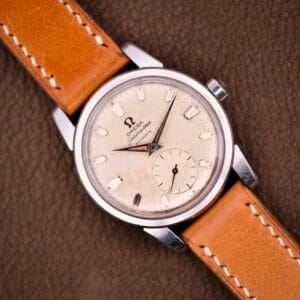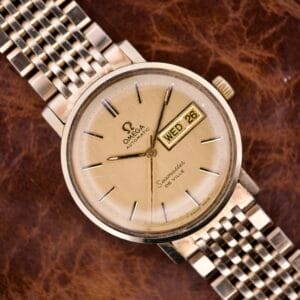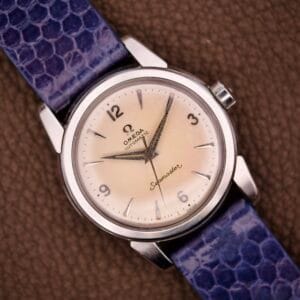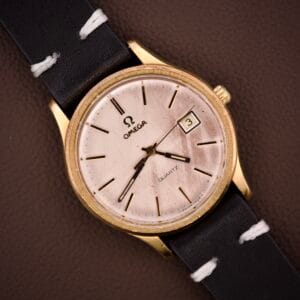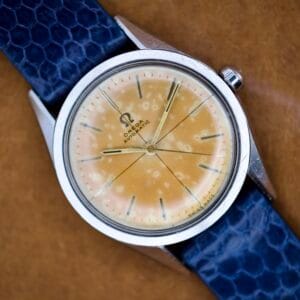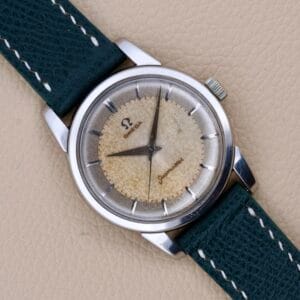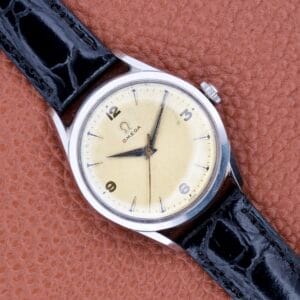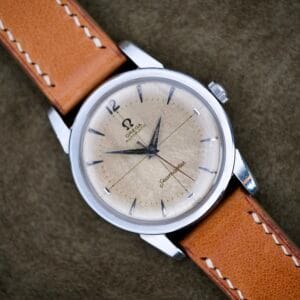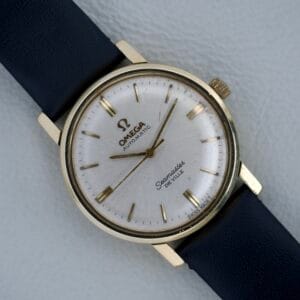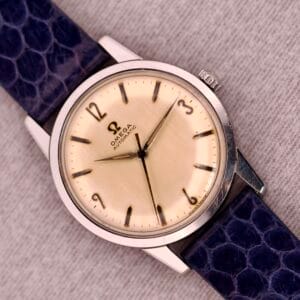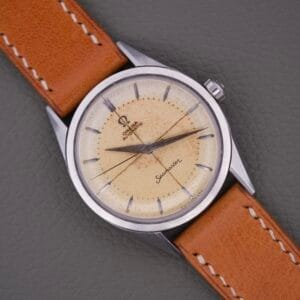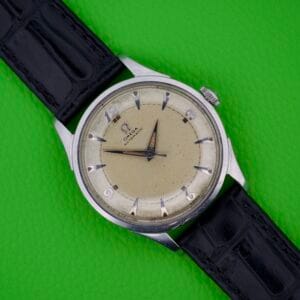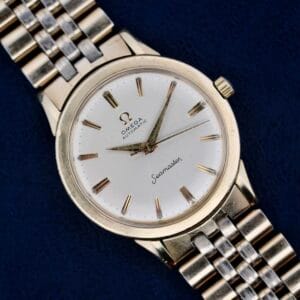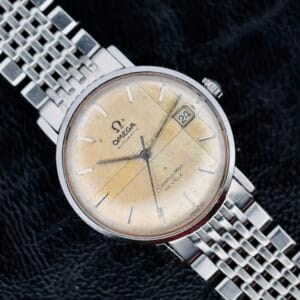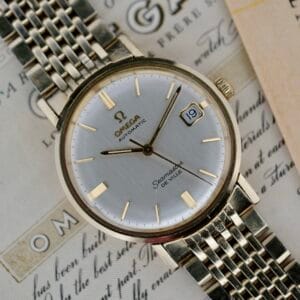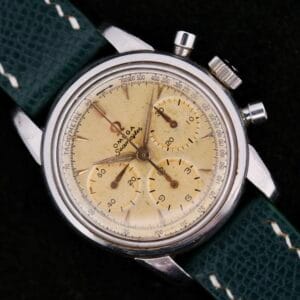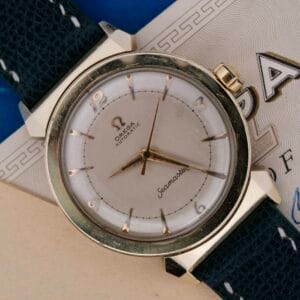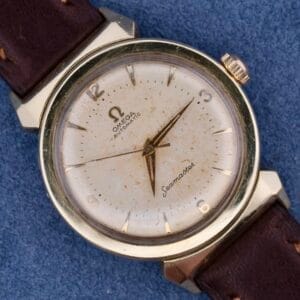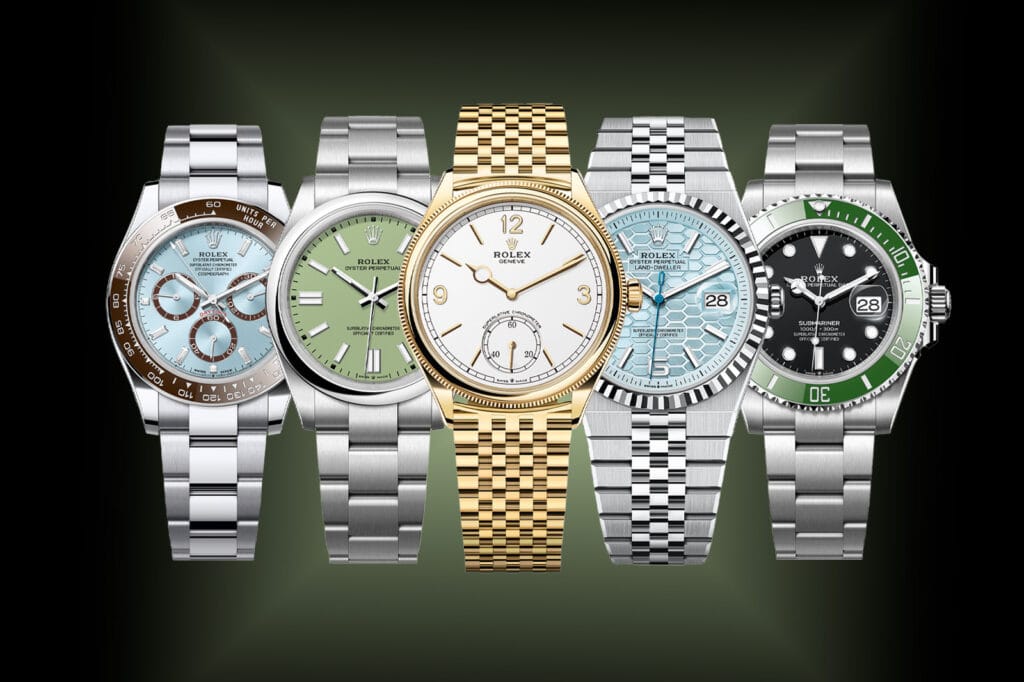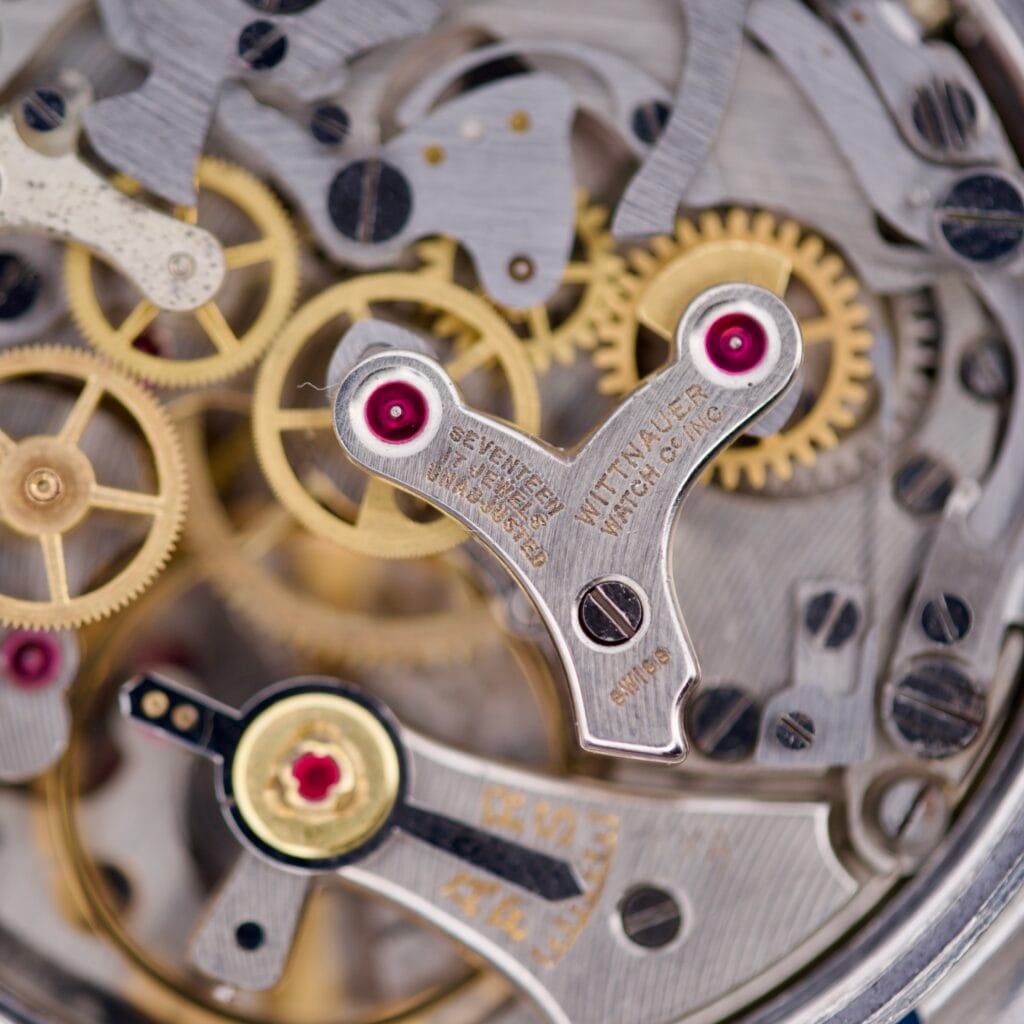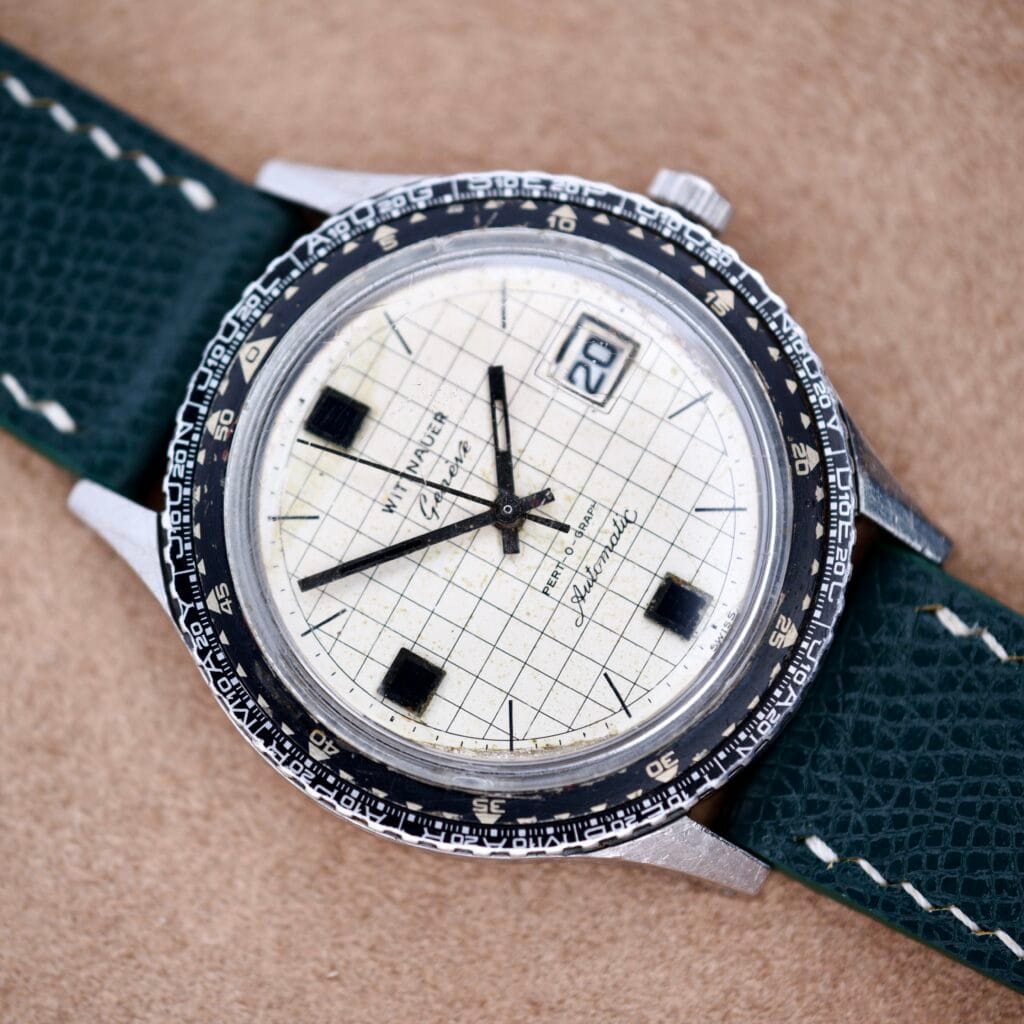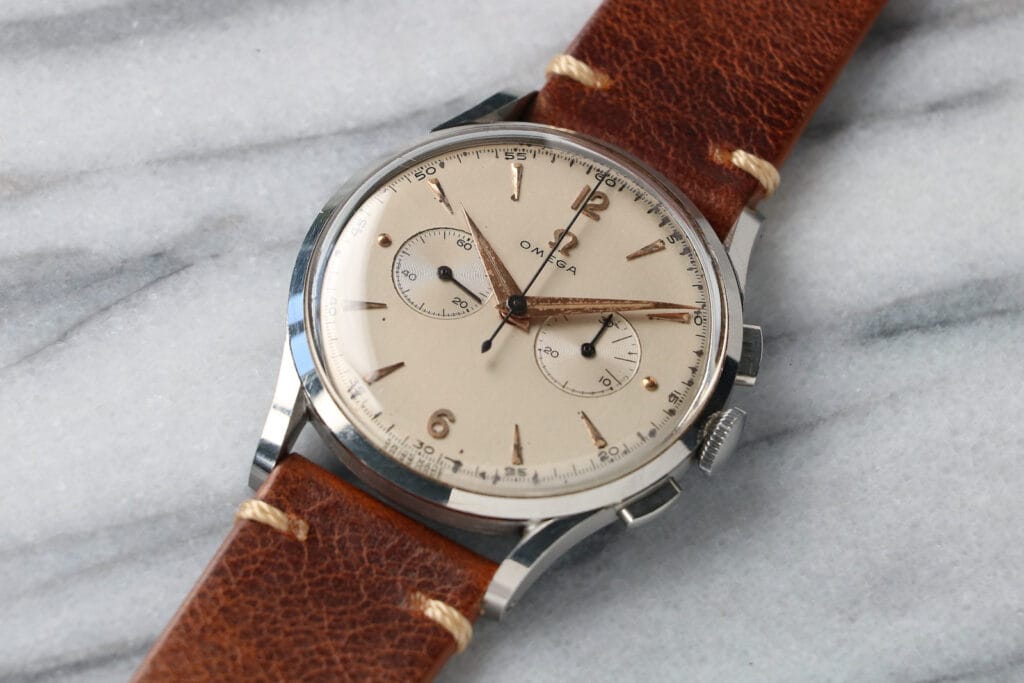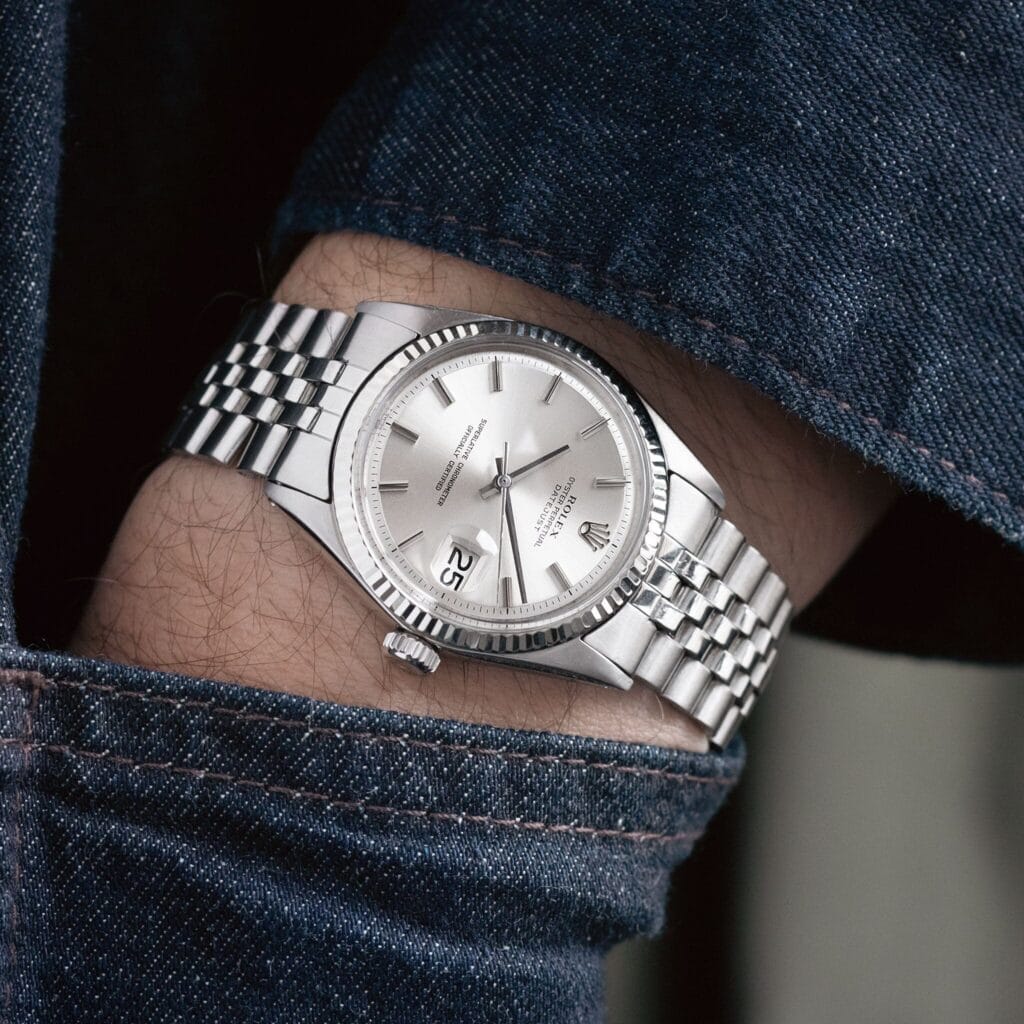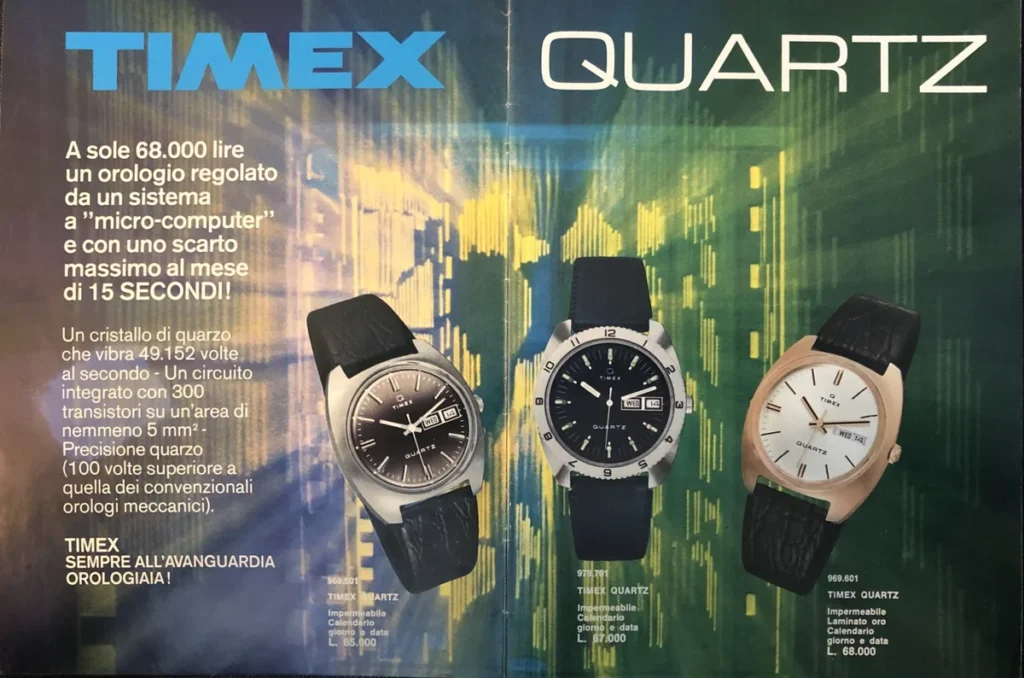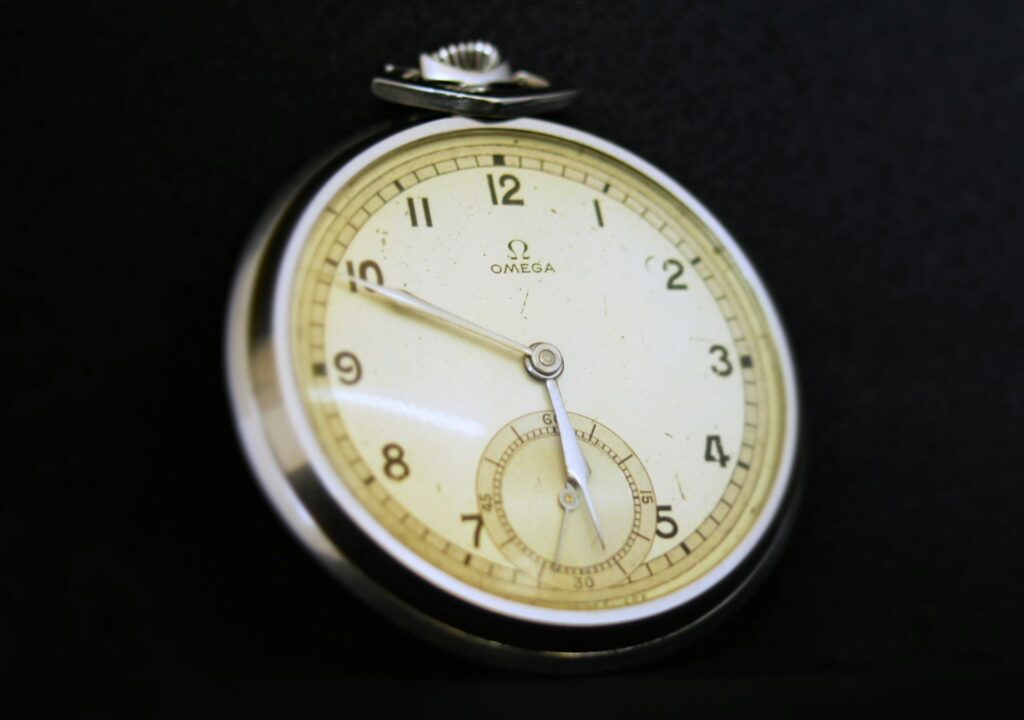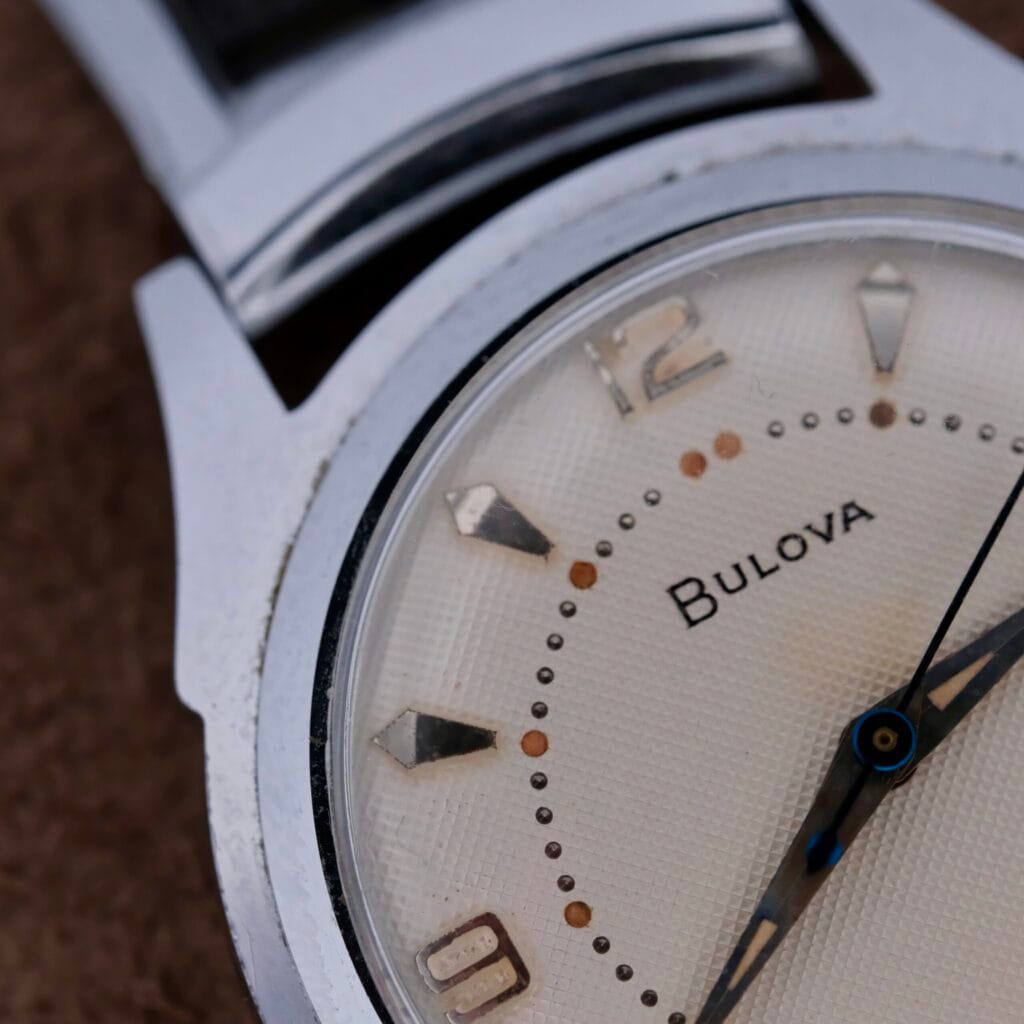Don't miss the next drop
The Ultimate Guide to Vintage Omega Seamasters
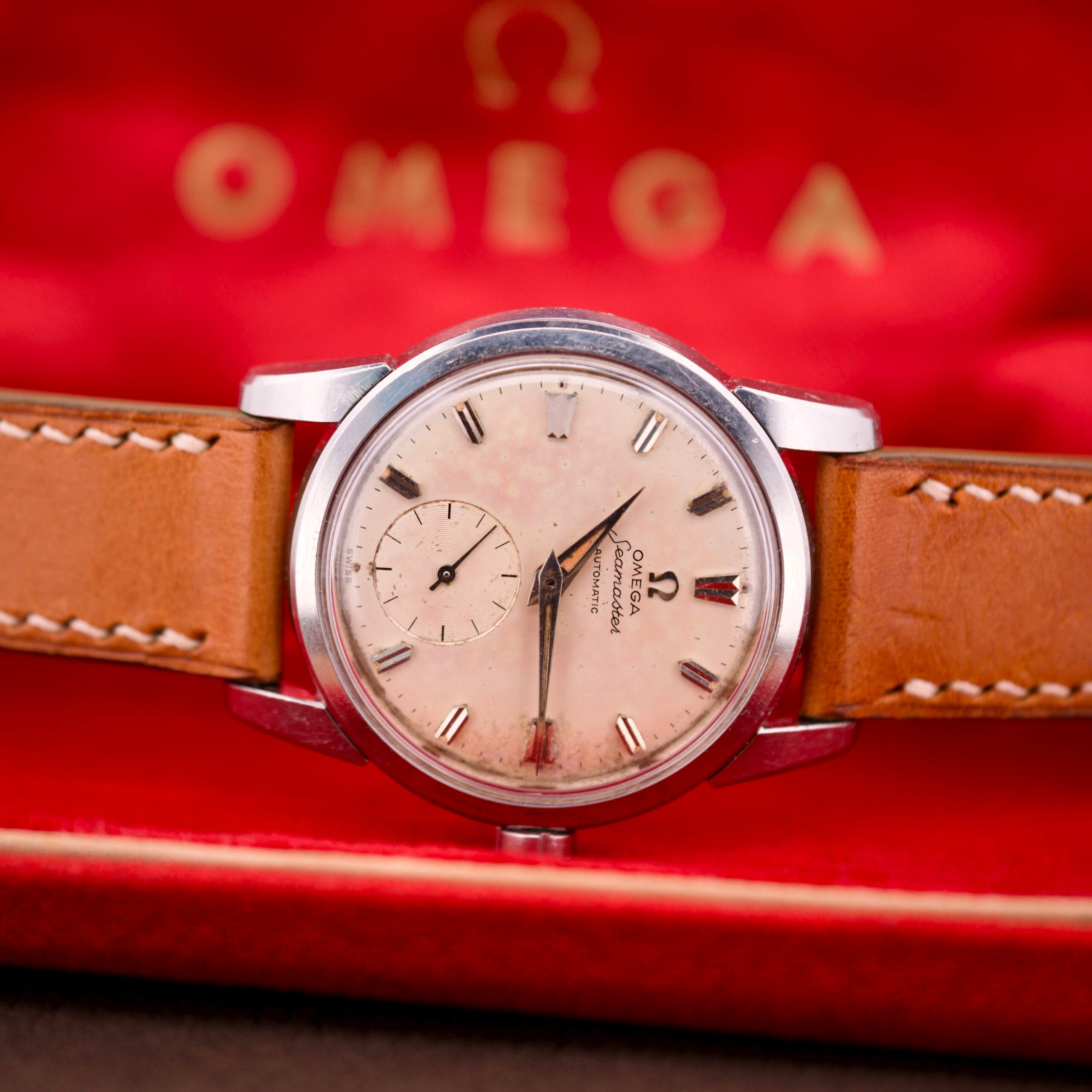
Vintage Omega Seamasters represent one of the most compelling propositions in watch collecting today – offering military provenance, technical excellence, and iconic design at prices significantly below comparable Rolex models. While a 1960s Rolex Submariner commands $15,000-$25,000, an equivalent Seamaster 300 costs $7,000-$12,000 despite matching quality. For collectors seeking authentic tool watch heritage without the premium associated with crown logos, vintage Seamasters deliver exceptional value.
From humble beginnings as elegant dress watches in 1948, Seamasters evolved into professional diving instruments that served Jacques Cousteau’s underwater expeditions, British Royal Navy divers, and COMEX saturation diving operations. This is the complete guide to understanding, evaluating, and acquiring these undervalued classics.
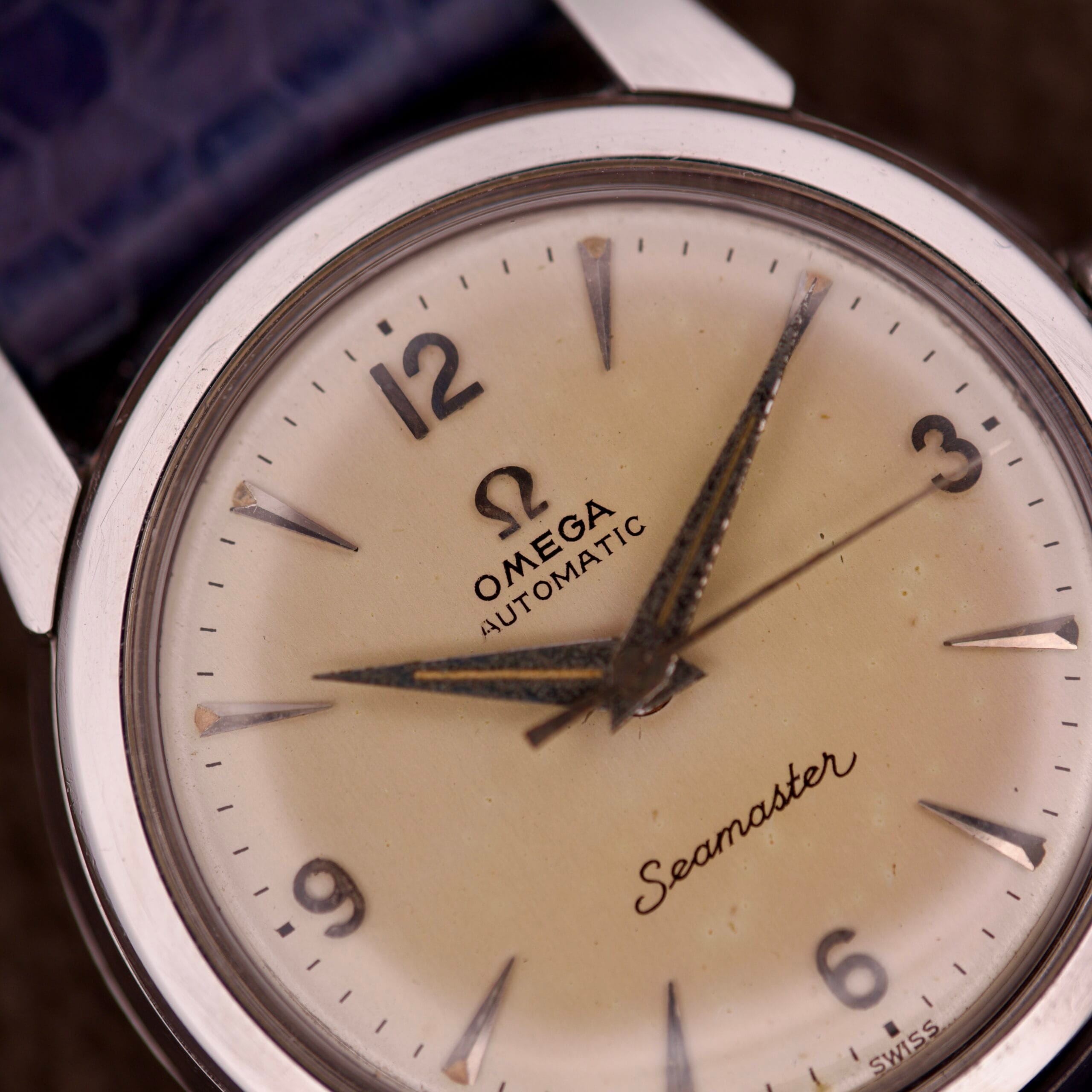
A Vintage Omega Seamaster Ref. 2828 View Item
From dress watch to deep-sea warrior
The Seamaster’s 1948 debut coincided with Omega’s 100th anniversary and the London Olympics, introducing civilians to military waterproofing technology developed during WWII. The revolutionary O-ring gasket system, adapted from submarine technology, represented a genuine advancement over the lead and shellac seals competitors used. These rubber seals maintained integrity from -40°C to +50°C, giving the original Seamaster a 60-meter water resistance rating – extraordinary for a 34mm dress watch of the era.
The early models featured caliber 500 and 501 movements with full-rotor automatic winding, swan neck regulators, and copper-colored finishes that became Omega’s signature. These weren’t rugged tool watches yet, they were refined timepieces for “town, sea, and country” wear, combining elegance with practical water resistance.
Everything changed in 1957 when Omega launched its legendary professional trilogy: the Speedmaster for racing, the Railmaster for scientists requiring anti-magnetic protection, and the Seamaster 300 for professional diving. The Seamaster 300 ref. CK2913 transformed the collection’s identity with its 39mm case, matte black dial, Bakelite rotating bezel, and distinctive triangular hour markers. The Naiad crown introduced pressure-activated sealing that actually tightened as depth increased – an innovation competitors couldn’t match.

Through the 1960s, the Seamaster 300 evolved from the elegant CK2913 (1957-1961) through the transitional ref. 165.014 (1962-1964) to the iconic “thick bezel” ref. 165.024 (1963-1971) with its 42mm case, bombé lugs, and full minute graduations. The British Royal Navy selected the 165.024 for divers from 1967-1971, issuing watches marked “0552” for Royal Navy and “W10” for British Army/SAS units. These military pieces now command $15,000-$26,000 versus $7,700-$12,000 for civilian versions.
The 1970s brought radical experimentation. The Ploprof 600 (ref. 166.077) launched in 1971 with its monobloc case, red bezel lock button, and tested depth rating of 1,370 meters – designed for COMEX saturation diving operations. Though commercially unsuccessful due to its massive 54mm size, the Ploprof earned respect from actual professional divers. The 1973 Seamaster 200 “SHOM” (ref. 166.0177) and 1978 “Baby Ploprof” (ref. 166.0250) continued this innovative spirit with angular cases and distinctive aesthetics.
Why the Seamaster matters in watchmaking history
The Seamaster’s significance extends beyond commercial success to genuine technical innovation and professional validation. As Omega’s longest-running collection in continuous production since 1948, it represents the brand’s core DNA: reliability meeting refinement, military capability delivered with elegant restraint.
The O-ring gasket innovation of 1948 became industry standard, while the pressure-activated Naiad crown system of 1957 offered a unique sealing solution that competitors couldn’t replicate. When COMEX tested all major dive watches in 1967-1968 for saturation diving, they exclusively selected Omega because it was “the only company guaranteeing hermetically sealed cases” at extreme depths. This wasn’t marketing – it was professional divers voting with their lives.
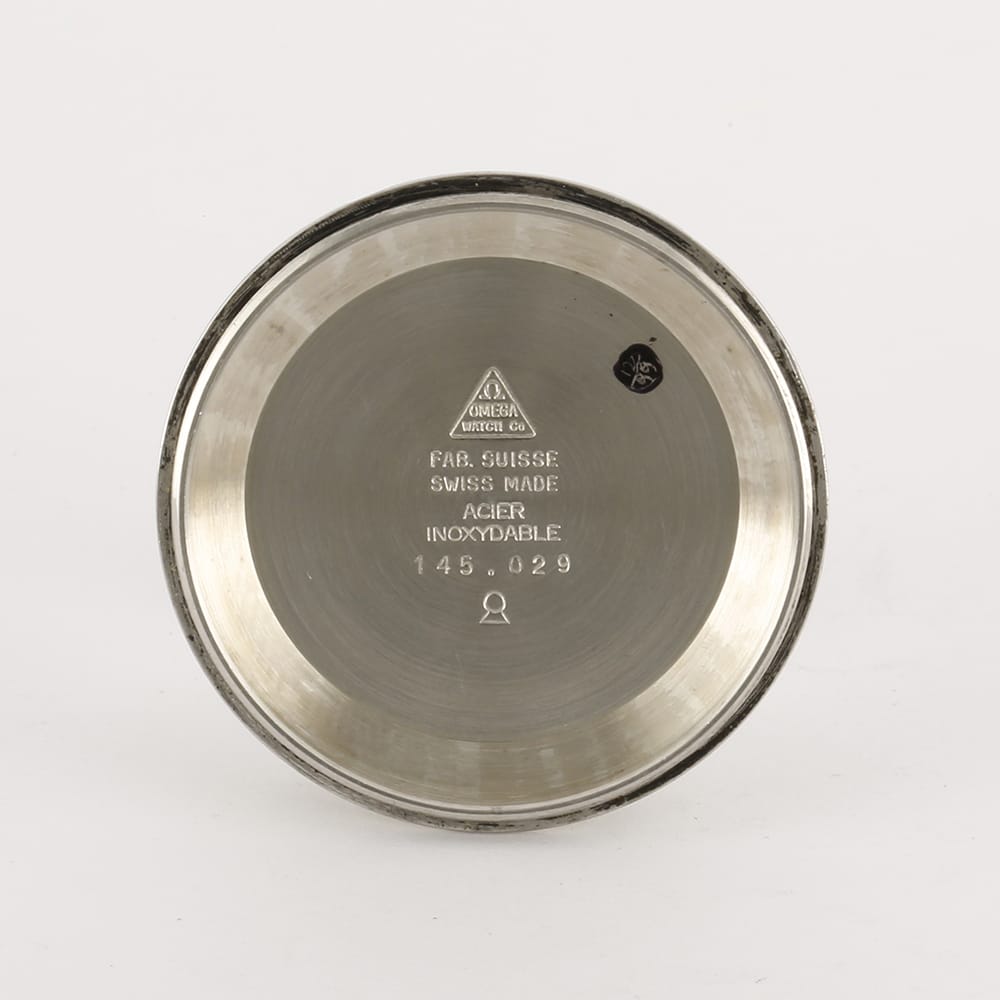
Military adoption validated these technical claims. Beyond the British forces, the French Service Hydrographique et Océanographique de la Marine selected the Seamaster 200 in 1978, while various air forces and special operations units chose Seamasters for harsh operational environments. When Jacques Cousteau’s Precontinent II expedition established the first permanent underwater habitat in 1963, Seamaster 300 watches were used four hours daily for eight days at 253-meter depths.
Within Omega’s hierarchy, the Seamaster occupied the practical middle ground – more versatile than the dress-focused Constellation, less specialized than the Speedmaster chronograph. This positioning allowed endless variation: from elegant De Ville variants with crosshair dials to radical Ploprof experiments. The caliber 500 and 550 series movements used across Seamasters rank among the finest automatic calibers ever mass-produced, with 24-jewel construction, swan neck regulation, and finishing that matched contemporary Rolex movements while costing less.
What makes vintage Seamasters collectible today
The vintage Seamaster market has matured dramatically, with top references appreciating 10-15% annually while remaining significantly undervalued compared to equivalent Rolex models. Understanding which models command premiums and why separates informed collectors from those who overpay for refinished examples.
The original Seamaster 300 ref. CK2913 (1957-1962) represents the holy grail for serious collectors. With eight sub-variations distinguished by hand configurations and bezel markings, pristine examples with original broad arrow hands, Bakelite bezels, and matching bracelets command $13,000-$27,000. Exceptional museum-quality pieces reach $30,000-$50,000, while military-issued examples add 30-50% premiums. The original Bakelite bezels alone are worth $8,000-$15,000 when available – they crack easily and most have been replaced.
The ref. 165.024 “thick bezel” generation (1963-1971) shows the strongest appreciation trajectory, rising from around $3,500 ten years ago to $7,700-$16,800 today – a 170% increase. British Royal Navy-issued examples with “0552/923” markings reach $15,000-$26,000, nearly double civilian equivalents. Circle-T dial variants indicating tritium lume carry premiums for collectors seeking period-correct radioactive material.
The Ploprof 600 (ref. 166.077) has outperformed the broader market with 32.3% appreciation over five years versus 19.3% average. Standard examples trade for $9,000-$15,000, while COMEX-issued prototypes command $40,000-$75,000+ due to extreme rarity. Mark I dial variants with distinctive printing are most desirable, and original mesh bracelets add $1,000-$2,000 to valuations.
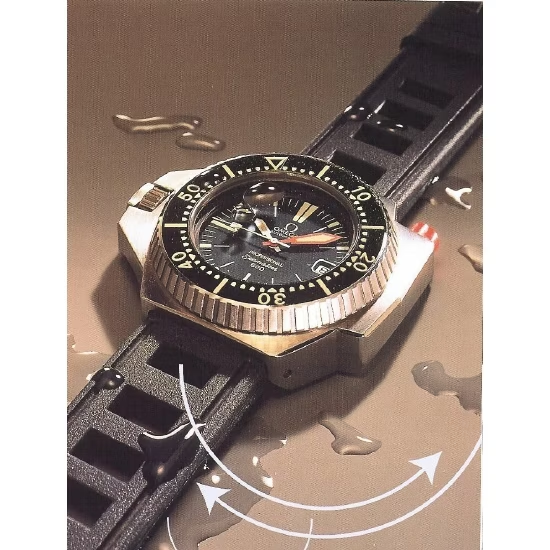
Dress Seamasters and De Ville models offer exceptional entry-level value. Standard 1960s steel automatics cost just $1,600-$2,000, projected to reach $1,800-$2,200 by 2026-2027. Solid gold examples in 14K or 18K trade for $2,800-$3,400. Special dial variations – golf ball textures, clamshell patterns, crosshair designs, ribbon motifs – command 30-50% premiums while remaining affordable. These early Seamasters use the same excellent caliber 552 and 565 movements as the expensive dive models but in elegant 34-35mm cases.
The critical value factors mirror those across vintage watches, but with Seamaster-specific nuances. Dial originality accounts for 70-90% of total value – a refinished dial reduces worth by 30-50% even when professionally done by Omega. Pre-1970s black dial Seamasters warrant extreme skepticism; approximately 99% are redials since black dials were exceptionally rare in original production. Service dials (factory replacements during maintenance) reduce value 20-40%, while aftermarket refinishing destroys 50-70% of worth.
Original parts carry enormous premiums. Those original Bakelite bezels on CK2913 models can be worth nearly as much as the entire watch. Correct period hands with matching patina to dial lume are essential – mismatched aging between hands and dial immediately signals replacement parts. Unpolished cases with sharp lugs and crisp edges command 20-30% premiums over heavily polished examples with rounded edges.
Provenance and documentation add substantial value. Extract from the Archives (Omega’s official production certification) adds 10-15% value for $80-200. Original boxes and papers command 15-25% premiums, while complete sets with boxes, papers, and hang tags reach 25-40% premiums. Military issue documentation can add 30-50%+ to value, while proven COMEX provenance multiplies values 2-5x.
Patina must be evaluated carefully. Desirable patina includes even “tropical” dial aging to warm cream or light brown tones, consistent lume aging across dial and hands, and honest wear appropriate to age. Problematic deterioration includes moisture spotting, bubbling lacquer, water damage rings, mismatched aging between components, and dial “cancer” that spreads across the surface.
Market trends strongly favor authenticity and originality as collector knowledge increases. Watches with multiple incorrect parts – so-called “franken-watches” – face declining values as buyers become more sophisticated. The market has bifurcated between excellent original examples appreciating steadily and compromised examples struggling to find buyers.
The technical excellence behind vintage Seamasters
Understanding the movements, construction quality, and technical evolution reveals why vintage Seamasters compete with any manufacturer from the era – including those costing significantly more today.
The 500-series automatic movements represent peak Omega manufacturing from 1956-1970s. Caliber 501 introduced the full-rotor automatic with 360-degree bi-directional winding, swan neck regulation, and 19-20 jewels. The caliber 552 became the mainstream workhorse – 28mm diameter, 24 jewels, 19,800 bph frequency, and finishing quality that watchmakers describe as “among the finest mass-produced automatic movements ever made.”
Properly serviced caliber 552 movements achieve accuracy within COSC chronometer specifications despite never receiving official certification. Real-world examples regularly perform at +/- 10-20 seconds per day, with exceptional specimens reaching +1 to +3 seconds daily. The beryllium copper gears provide enhanced durability, while the swan neck regulator enables fine adjustment typically reserved for chronometer-grade calibers.
The caliber 565 introduced in 1966 added quickset date function – the first Omega movement with rapid date correction. This 24-jewel movement powered both the Seamaster 300 ref. 166.024 and military-issued models, earning reputation for “superb” reliability and accuracy. Well-maintained examples serve decades with minimal intervention beyond regular servicing every 5-7 years.
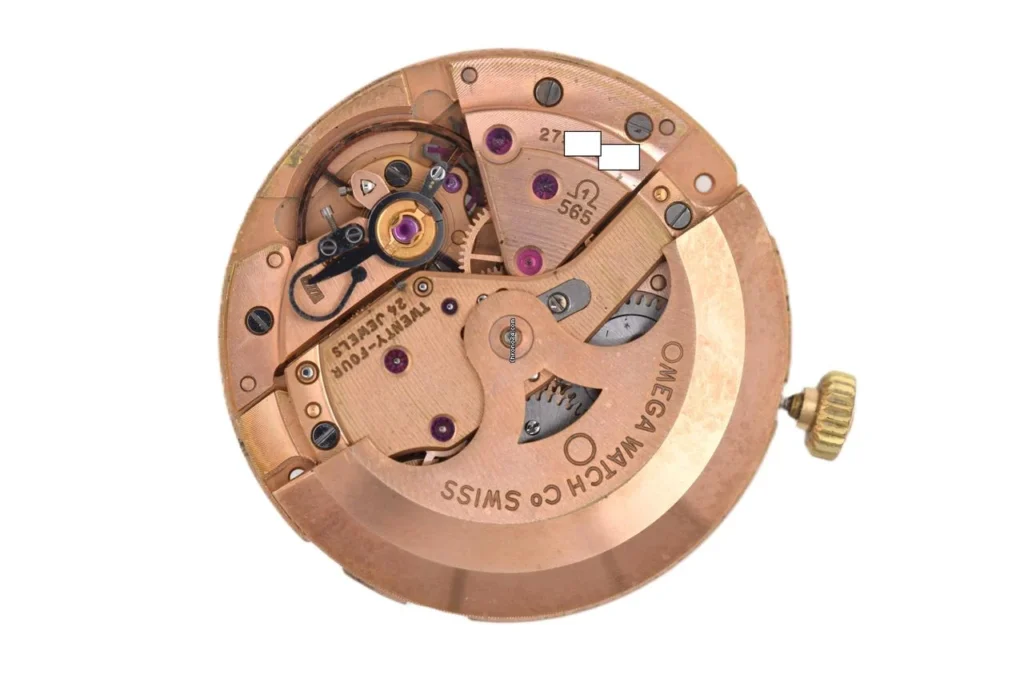
Movement serviceability remains excellent across all major calibers – parts availability through Omega, third-party suppliers, and donor movements keeps even 60-year-old watches running. Standard service costs $300-500 from quality independent watchmakers, though Omega factory service exceeds $1,000 with case refinishing and restoration included. The straightforward, logical movement construction facilitates service by competent watchmakers worldwide.
The primary technical weakness affects caliber 550: brass bushes instead of jewels in the automatic winding assembly (a cost-cutting measure for U.S. import duty avoidance). These bushes wear over time, and many examples have replacement jeweled bridges installed – an acceptable modification that improves durability. The 1970s-1980s caliber 1020 series represents a quality decline with more fragile construction, leading experienced collectors to avoid most Omegas from 1975-1985 as “low rent” production.
Case construction quality matches movement excellence. Omega primarily used 316L stainless steel in robust two-piece construction – case body with snap or screw back. The solid construction and full-thickness case backs provide excellent moisture and dust resistance. Press-fit case backs close with satisfying precision, while screw-back dive models feature the distinctive hippocampus (seahorse) embossing that became the Seamaster trademark.
Gold-capped cases represent the second-best option after solid gold. Omega bonded 14K gold sheet approximately 200 microns thick (0.2mm) under heat and pressure to stainless steel bases. This thick gold layer withstands significant polishing – far superior to thin gold plating. The telltale characteristic is exposed stainless steel on the rear of lugs and the stainless case back (matching steel threads). These cases rarely wear through but commonly suffer over-polishing that rounds sharp lugs.
Gold-filled cases offered complete coverage including case back interiors and threads, typically in 10K or 14K gold over base metal (not stainless). U.S. market Seamasters often feature gold-filled cases with 10-25 year wear ratings. The vulnerability is wear-through at high-contact areas – bezel edges, lug tips, and case backs. NATO straps must be strictly avoided on gold-filled cases as they grind through plating catastrophically.
Gold plating became common in the 1970s-1980s as cheaper alternative, with typical 20-micron thickness (0.02mm) though premium Omega used 40-80 microns earlier. These thin layers cannot withstand polishing and limit restoration options.
Water resistance evolution showcases Omega’s innovation. The 1948 O-ring gasket system achieved 60-meter ratings – revolutionary for dress watches. The 1957 Seamaster 300 received 200-meter certification with confidence it exceeded 300 meters (testing equipment limitations prevented verification). The Naiad crown system used pressure-activated springs that sealed tighter at depth. By 1971, the Ploprof achieved tested depths of 1,370 meters using monobloc case construction and hermetically sealed design that prevented helium ingress rather than requiring escape valves.
However, collectors must recognize that vintage Seamasters can never be considered truly water-resistant after 40-60 years regardless of service claims. Gasket deterioration, micro-fissures in cases, thread wear, and crystal seal degradation create multiple failure points. Even hand washing risks moisture ingress if seals are compromised. Water damage to vintage dials is essentially irreparable and destroys significant value. These watches should be enjoyed as dress pieces with splash resistance only.
Crystal materials reflect era-appropriate technology. Vintage Seamasters universally used acrylic (hesalite/plexiglass) crystals – soft, easily scratched, but flexible and shatter-resistant. These 1-2 Mohs hardness crystals scratch easily but polish out effortlessly with PolyWatch or toothpaste. The domed profiles and excellent clarity without anti-reflective coatings deliver authentic vintage character. Sapphire crystals only became standard in the 1980s, so acrylic crystals are period-correct and desirable for authenticity.
Comparing Omega build quality to Rolex reveals essential parity despite price gaps. Vintage watch experts note “the quality difference between my 60’s Seamaster and my 60’s Datejust is not that noteworthy.” Both brands produced reliable, robust watches with high precision movements and excellent case construction. Rolex advantages include 904L stainless steel (more corrosion-resistant than Omega’s 316L) and superior marketing/brand-building. Omega advantages include movement decoration visible through display case backs and superior anti-magnetic capabilities. The critical insight: vintage Seamasters deliver 80-90% of Submariner quality at 40-60% of the cost.
OMEGA Value Propositions
Your comprehensive buyer’s guide to vintage Seamasters
Acquiring vintage Seamasters requires navigating authentication challenges, condition assessment, and understanding acceptable versus problematic characteristics. This systematic approach protects against the fake dials, “franken-watches,” and misrepresented pieces that plague the vintage market.
Authentication starts with serial number verification. Vintage models have serial numbers engraved inside the case back (accessible only when opened), while later models show numbers on lug backs. Format follows 7-digit (pre-1944) or 8-digit (post-1944) patterns. Cross-reference these numbers with Omega’s Vintage Database to verify production dates and specifications. Movement serial numbers should date appropriately to case production (within 1-2 years for high-volume models).
Reference numbers inside the case back identify the specific model. Use these reference numbers in the Omega Vintage Database (adding zeros as needed for 3.3 digit references – 135.007 becomes 135.0007) to confirm correct caliber movement and dial configuration for that reference.
Movement inspection is absolutely critical and non-negotiable. Always request case-open photos before purchase. Genuine Omega movements feature distinctive copper or rose gold plating – a hallmark of authentic production. Check for proper Omega engravings on bridges and plates, quality finishing showing meticulous craftsmanship, and the correct caliber matching reference specifications. Modern Co-Axial Seamasters should have black balance wheels – silver or grey indicates counterfeits. Visible rust, poor finishing quality, or generic movements with Omega dials are immediate disqualifications.
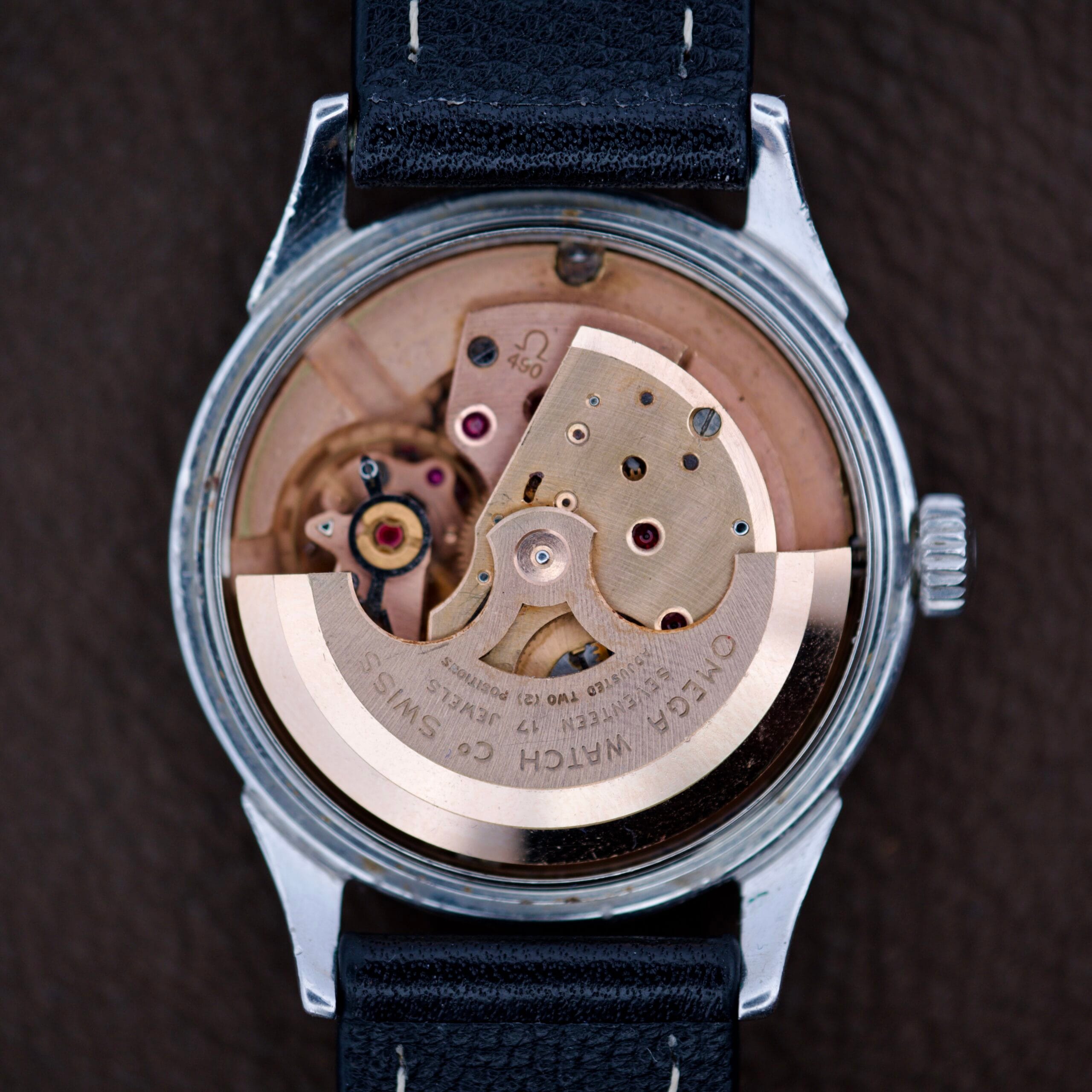
Dial authentication requires understanding specific red flags that instantly identify fakes. NEVER accept dials printing “Antimagnetic” or “Incabloc” – Omega never used these words on dials. Similarly, jewel counts marked on dials (e.g., “17 Jewels” or “17 Rubis”) immediately indicate counterfeits. The Omega logo must be crisp, well-aligned, and applied as a separate metal piece rather than painted. Text printing requires perfect spacing, consistent fonts, and zero bleeding. Minute and seconds markers must be precisely aligned and evenly spaced. Any spelling errors anywhere guarantee fakes.
Pre-1970s black dial Seamasters warrant extreme skepticism – approximately 99% are redials since black dials were exceptionally rare in original production. Refinished dials may lack “Swiss Made” markings or show inconsistent patina compared to hands. Look for mirror-smooth finishes on vintage black dials when originals should show age. Compare lume color between dial plots and hands – mismatched aging signals replacement parts or refinishing.
Case and crown authentication involves recognizing Omega’s “genetic signature” through familiarity with authentic examples. Beware elaborate gold hallmarks on the OUTSIDE of case backs – Omega didn’t mark externally this way, and this characteristic strongly suggests fakes. Post-1950 civilian models should have signed crowns with Omega symbols and signed crystals. The 1950s Seamaster automatics typically featured distinctive “clover” crowns. Crown operation should be smooth and precise, with screw-down crowns threading cleanly.
Condition assessment prioritizes dial condition above all else – up to 90% of value depends on dial originality and preservation. Original dials show natural aging appropriate to age; refinished dials appear suspiciously perfect on aged cases or show inconsistent patina. Look for even, natural patina matching between dial and hands. Check for moisture spotting (irregular dark spots indicating water damage versus desirable even aging), bubbling or flaking paint, and firmly attached hour markers without visible glue residue.
Acceptable patina includes even “tropical” dial effects where white or cream dials age to golden champagne tones, uniform lume aging to cream or light brown, and honest wear consistent with age. Problematic deterioration includes spotty moisture damage, uneven discoloration, bubbled lacquer, water damage rings, mismatched aging between components suggesting replacement parts, and spreading “dial cancer.”
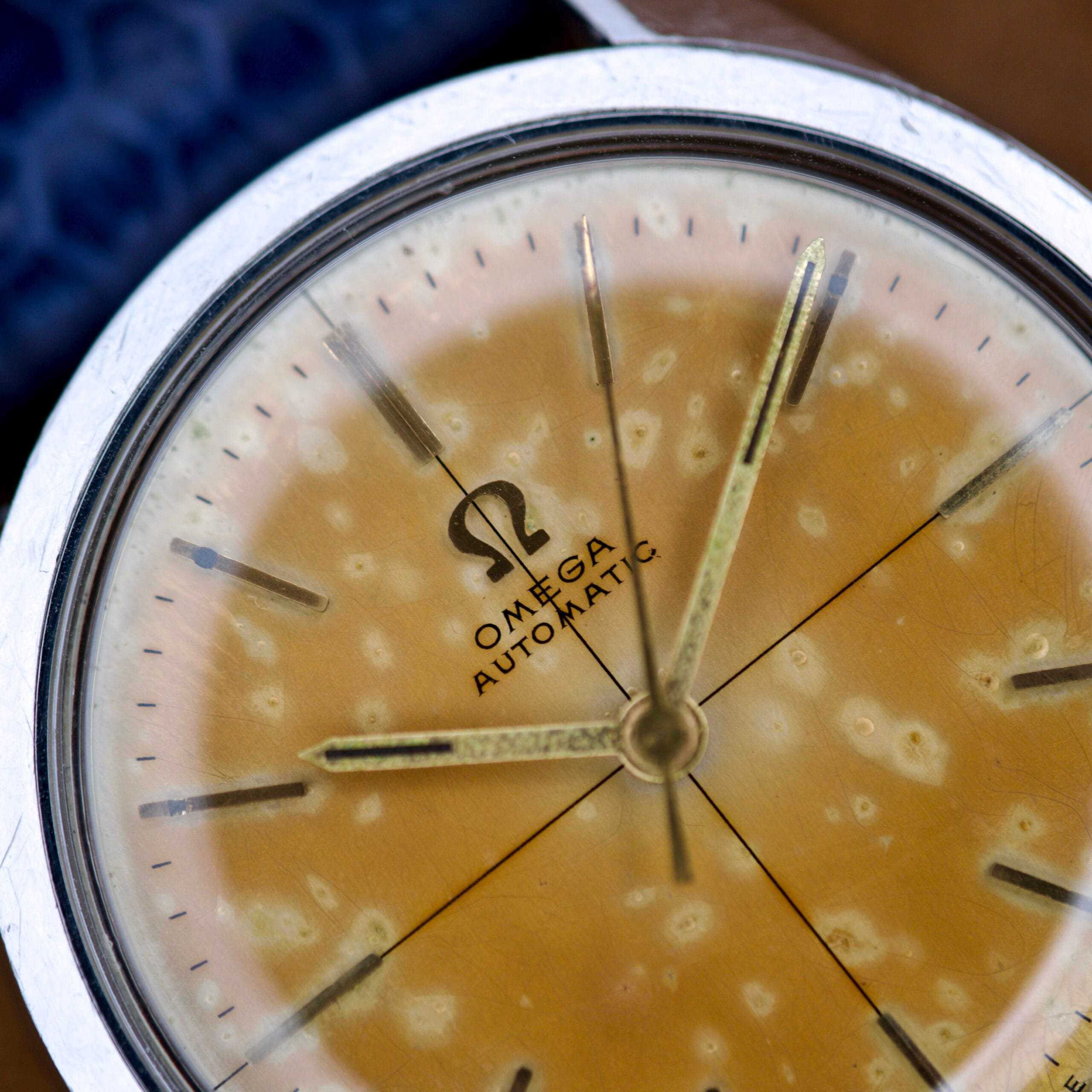
Case condition should show minor scratches expected with vintage pieces – this is normal wear. The critical red flag is over-polishing that rounds lugs, loses sharp edges, and thins case walls. Original case geometry with crisp, defined edges is essential. Inspect case back sealing surfaces for pitting or corrosion affecting water resistance restoration. Gold-plated cases should be checked whether gold has been stripped from excessive wear. Tube areas where crowns attach commonly show wear or corrosion.
Hand condition requires matching patina to dial aging – consistent coloring indicates original sets. Lume in hands should match dial lume color and deterioration level. Hand corrosion is common as lume becomes hygroscopic over time, attracting moisture. Stamped hand edges often corrode first since plating doesn’t cover edges. Replacement hands are acceptable IF correct style for model and period, though they reduce value. Check that hands move smoothly without touching dial or each other.
Movement condition ideally shows clean components with minimal visible wear, no rust or oxidation on plates and bridges, and smooth accurate operation. Date mechanisms should change cleanly – never adjust dates between 8PM-4AM when gears are engaged. Absence of hacking features (second hand stopping when setting time) is normal in many vintage movements and not concerning. For automatics, rotors should spin freely without grinding sounds.
Original parts versus acceptable replacements significantly impacts value and authenticity. Dials should always be original – even professional Omega refinishing reduces value 30-50%+ because collectors prize untouched originality. Hands should be correct style for model and era with matching patina. Cases must be original with reference numbers matching movements. Movements must be correct calibers for reference specifications.
Acceptable replacements include crowns (often replaced during service but should be correct Omega parts), crystals (commonly replaced due to wear, must be correct type and size), gaskets and seals (expected replacements during service), and case tubes (acceptable for water resistance restoration). Refinished dials reduce value 30-50% even with quality work, replacement hands reduce value 10-20% if wrong style, while service replacement parts minimally impact value if correct parts were used. Multiple incorrect replacements create “franken-watches” that should be avoided entirely.
Common problems include water and moisture damage (the major concern for vintage Seamasters), case corrosion (pitting under case back gasket areas from decades-old gaskets turning to “black goo”), dial deterioration from moisture or UV exposure, hand corrosion especially where lume was applied, and crown/stem issues with worn seals being the most common water ingress point.
Service history importance cannot be overstated. Documentation confirms proper professional maintenance, indicates parts availability was addressed while parts remained obtainable, shows whether water resistance was restored and tested, and documents legitimate part replacements. Vintage movements require servicing as oils dry out over 25+ years. Certain parts like chronograph center wheels for Valjoux 72 or Omega 321 are increasingly scarce and expensive ($300+ for rare components).
Look for recent service within five years, pressure testing results if applicable, documentation of replaced parts, service by reputable watchmakers or Omega Service Centers, and evidence gaskets, seals, and crown tubes were replaced. Watchmaker service marks scratched inside case backs show service history even without documentation.
Where to acquire vintage Seamasters with confidence
The vintage Seamaster market offers diverse buying channels with dramatically different risk profiles, buyer protections, and value propositions. Matching your experience level to appropriate sources protects against costly mistakes.
Trusted specialized dealers provide maximum protection for beginners and valuable pieces. Top-tier dealers include OTTUHR offering curated vintage and modern Omega selections with authentication and warranties; Bob’s Watches featuring Seamaster 300 from 1950s-60s at $8,000-$20,000+ with over 20 years experience and authentication guarantees; CHRONEXT providing meticulous master workshop inspection with 24-month warranties; and Omega Enthusiast Ltd specializing exclusively in vintage Omega with watchmaking backgrounds.
Additional reputable dealers include Ashton-Blakey Vintage Watches offering gold and stainless Seamasters from 1948 onward, Second Time Around Watch Company (established 1976) providing affordable quality pieces, and Cool Vintage Watches with extensive 1940s-1970s inventory ranging $765-$9,675+.
Dealer advantages include expert authentication and inspection, warranties typically 12-24 months, serviced and ready-to-wear condition, return policies often 7-14 days, detailed documentation, after-sales support, and dramatically lower risk for beginners. The tradeoff is 20-40% price premiums over private sales and limited inventory compared to marketplaces.
Major auction houses offer access to rare pieces and museum-quality examples. Phillips (phillips.com/watches) holds undisputed worldwide market leader status, having sold Paul Newman’s Daytona for $17.75 million and consistently achieving 100% “white glove” sales. Their PERPETUAL service offers private treaty sales at fixed prices. Sotheby’s (sothebys.com/watches) conducts regular Important Watches auctions globally with specialized thematic sales. Christie’s (christies.com/watches) provides major presence with private sales and online auctions. Bonhams (bonhams.com), Antiquorum (antiquorum.swiss), and Heritage Auctions (ha.com) complete the auction landscape.
The auction buying process requires registration with ID and payment information, reviewing detailed online catalogs with estimates, attending preview exhibitions for physical inspection, researching comparable sales, and deciding on bidding methods (live, phone, or online/absentee). Buyer’s premiums of 15-25% get added to hammer prices, and return rights are severely limited with most sales “as is.” Auctions excel for rare pieces, detailed provenance, professional authentication, and competitive pricing on less-hyped models, but require experience navigating bidding dynamics and accepting significant condition risk.
Online marketplaces democratize access but require careful dealer vetting. Chrono24 (www.chrono24.com) dominates with 9 million monthly users and thousands of vintage Seamasters from global dealers. Their Trusted Checkout escrow service, strict dealer vetting (photo ID, business address, tax verification), buyer protection programs, and authentic customer reviews provide security. The 1916 Company formerly WatchBox (www.the1916company.com) owns every watch sold rather than operating as marketplace, with Swiss-trained watchmakers authenticating and servicing all pieces before 2-year warranty coverage. 1stDibs (www.1stdibs.com) curates vintage offerings from top dealers worldwide with premium marketplace positioning.
eBay (www.ebay.com) presents the highest risk despite largest selection and competitive prices. Approximately 99% of pre-1970s black dial Seamasters on eBay are redials, and “franken-watches” with mismatched parts proliferate. Only experienced collectors with authentication expertise should purchase through eBay, despite buyer protection programs, because verification is exceptionally challenging and misrepresentation is common.
Online forums with sales sections include Omega Forums (omegaforums.net) offering private watch sales and professional dealer listings with community authentication help, WatchUSeek (watchuseek.com) providing large active marketplace with extensive Omega knowledge base, and TimeZone (forums.timezone.com) hosting established marketplace with long-standing members. These forums offer direct collector-to-collector sales with better prices than dealers, community vetting, and transparent communication, but provide no formal buyer protection and require using escrow services. WatchPatrol (watchpatrol.net) aggregates listings from multiple forums for efficient searching.
Authentication services add verification security for significant purchases. Omega’s Heritage Department Certificate of Authenticity costs 800 CHF (approximately $880) requiring watch submission to Omega headquarters in Bienne, Switzerland. Watchmakers open watches to verify all original parts and check working condition while heritage teams access historical production records. Certificates include complete history, production dates, original specifications, and delivery details – adding provenance that increases resale value. Watches return in neo-vintage red heritage boxes. The limitation: all parts must be original to qualify.
Extract from the Archives costs just 120 CHF (approximately $130) providing production date confirmation and basic specifications online without physical inspection – useful for verifying production details but not authenticating physical watches or parts originality.
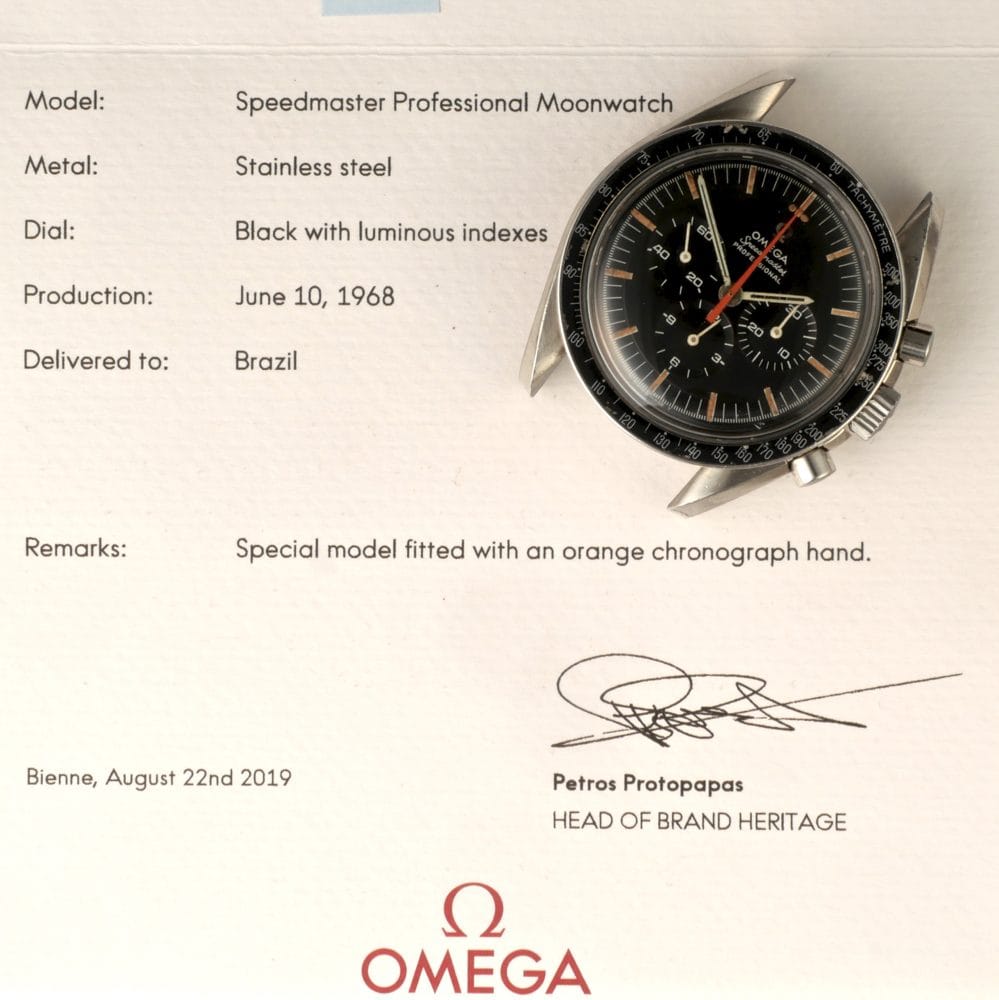
Third-party authentication includes Real Authentication (realauthentication.com) offering online authentication using latest technology, LegitCheck (legitcheck.app) specializing in Speedmaster and Seamaster authentication with 100% human experts analyzing detailed photo submissions, and Bob’s Watches in-house authentication for purchases.
Watch fairs and shows enable hands-on evaluation before purchase. Major events include Watches and Wonders Geneva (April 1-7, 2025, with public access last three days), WindUp Watch Fair (rotating between San Francisco, New York, and Chicago with free admission), and London Watch Fair (January 19, June 29, October 12, 2025 at Sheraton Skyline Hotel Heathrow with 70+ dealers).
European fairs include Furtwangen Antique Watch Fair (August 29-31, 2025, the largest antique watch fair in Europe established 1984), Munich Eurotime Watch Fair (since 1997), and Zurich Watch Collectors’ Market (twice yearly at Volkshaus Zurich with 70 Swiss dealers). North American events include Miami Beach Antique Show (January annually with 600+ dealers from 30+ countries).
Verifying dealer reputation requires systematic research. Google the dealer name plus “reviews,” check watch forums for mentions, search for problem reports, review Better Business Bureau or equivalent agencies, and determine business longevity. Platform verification includes checking Chrono24 “Trusted Checkout” status and dealer ratings, eBay feedback scores and detailed comments, and forum post counts with join dates.
Red flags include prices far below market value, unwillingness to provide additional photos, pressure to buy quickly, requests for unusual payment methods like Western Union or cryptocurrency only, no return policy whatsoever, unwilling to answer specific questions, no physical address or phone number, generic stock photos instead of actual watch images, and recently created accounts with no history.
Green flags include long business history (5+ years), active watch community participation, detailed condition descriptions, multiple high-quality photos including movement shots, transparency about service history and issues, clear return policies, responsive communication, authenticity guarantees, available references, and verified business credentials.
Navigating notable vintage Seamaster references
Understanding specific references, their characteristics, production periods, and current valuations enables informed collecting decisions across the Seamaster spectrum from affordable dress watches to investment-grade dive models.
The Seamaster 300 ref. CK2913 (1957-1962) represents the foundational professional dive watch. These 39mm stainless cases with straight lugs housed caliber 500 (17 jewels for U.S. market) or caliber 501 (19-20 jewels for export markets) movements. The distinctive matte black dials featured triangular hour indices with recessed radium plots, white Arabic numerals at 3-6-9-12, and 60-minute bidirectional Bakelite bezel inserts. The hippocampus symbol appeared on case backs from late 1957, while original 7077 flat-link bracelets with #6 end links are now worth $2,000-$4,000 independently.
Eight variations (CK2913-1 through CK2913-8) distinguished by bezel types (countdown versus count-up) and hand configurations create collecting complexity. The “broad arrow” configuration with large arrow hour hands and pointed minute hands is most desirable. “Lollipop” seconds hands with circular luminous tips command significant premiums. Current values range $13,000-$27,000 for good examples, reaching $30,000-$50,000 for pristine pieces with original bezels and bracelets.
The ref. 165.024 “thick bezel” generation (1963-1971) offers the best value proposition for collectors seeking authentic 1960s dive watch character at accessible prices. These 42mm watches with twisted “bombé” lugs, wider bezels with full minute graduations, and asymmetrical cases with crown guards represented major redesign. The 165.024 featured no date while 166.024 added date windows at 3 o’clock. Caliber 552 (no date, 24 jewels) or caliber 565 (with date, 24 jewels) provided 19,800 bph reliability.
Four dial configurations, four handset variations, and eleven bezel insert variations through production create collecting depth. Hour markers evolved from triangular to trapezoidal, while late 1960s examples featured elegant sword hands. Current civilian market prices span $7,700-$16,800 depending on condition and dial variant, while military issued examples reach $15,000-$26,000. The 170% appreciation over the past decade (from approximately $3,500 to current levels) demonstrates strong market momentum.
The Ploprof 600 ref. 166.077 (1971-late 1970s) represents Omega’s most radical professional diving innovation. The name “PLOngeur PROFessionnel” (Professional Diver) describes watches developed for saturation diving with monobloc stainless steel cases measuring massive 54mm × 45mm × 15mm. The 4mm thick sapphire crystals, asymmetrical design with crown at 4:00 and distinctive red unlock button at 2:00, lockable rotating bezels requiring red button activation, and tested depths of 1,370 meters (rated 600m) delivered extreme capability.
Caliber 1002 automatic movements with 28,800 bph frequency and 42-hour power reserves provided professional-grade reliability. The hermetically sealed design prevented helium ingress rather than requiring escape valves like competitors. Mark I dial variants with distinctive printing are most collectible. Current pricing spans $9,000-$15,000 for standard examples with original dials and bracelets, reaching $15,000-$20,000 for complete sets, while COMEX-issued prototypes command $40,000-$75,000+ due to extreme rarity.
The Seamaster 200 “SHOM” ref. 166.0177 (1973-late 1970s) debuted at Basel Fair 1973 with angular, beveled 42mm × 49mm lugless design. Multiple chamfers connecting case surfaces, large crowns, mesh bracelet integration, matte black dials with sword hands, and dates at 3:00 created distinctive 1970s aesthetic. Caliber 1012 movements (23 jewels, 28,800 bph, 42-hour reserve) powered 200-meter water resistance. The “SHOM” nickname derives from 1978 selection by Service Hydrographique et Océanographique de la Marine (French government) with small batches engraved “SHOM” on case backs. Current values span $3,000-$5,000 for standard examples and $4,000-$8,000 for SHOM-marked pieces.
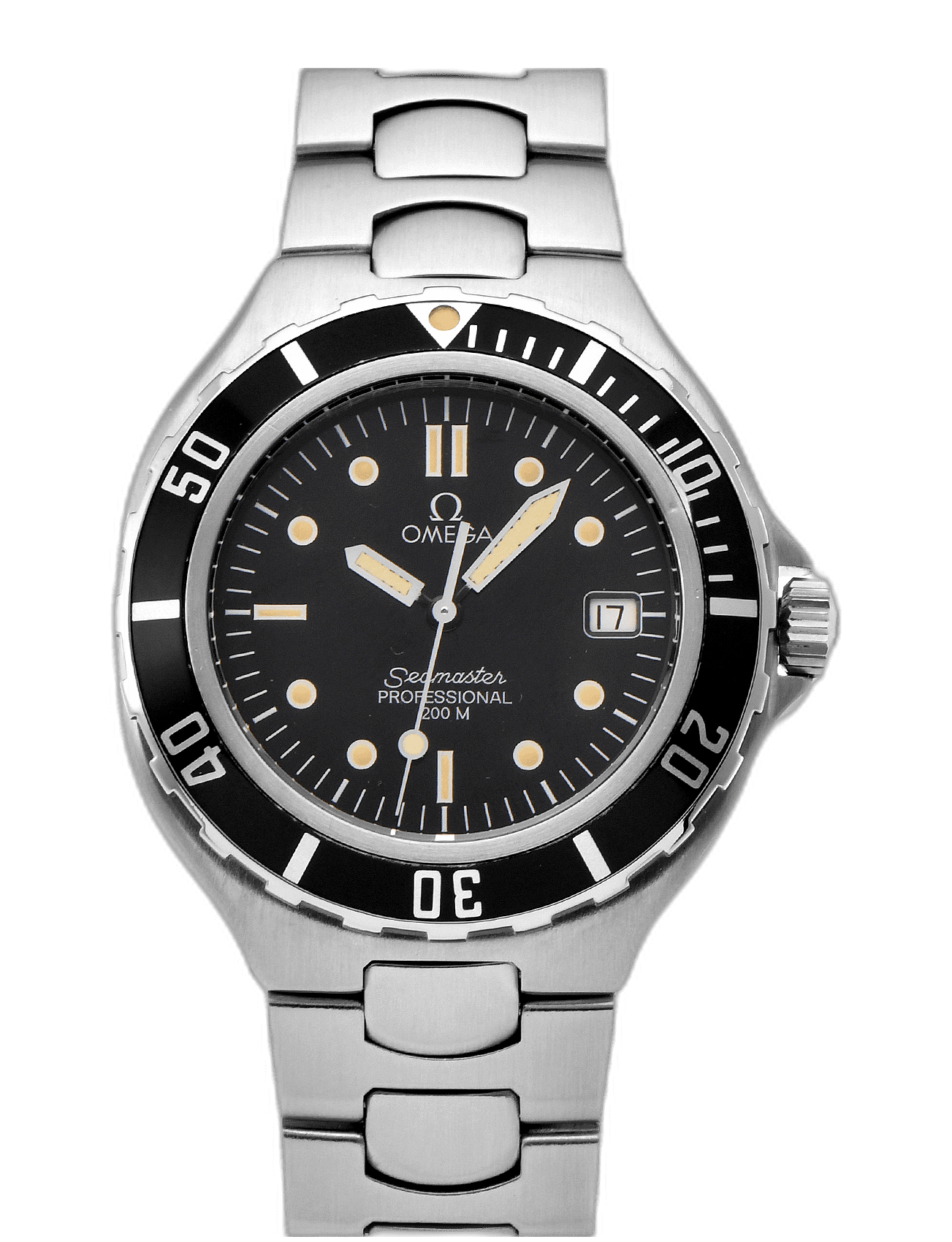
The “Baby Ploprof” ref. 166.0250 (1978-early 1980s) delivered Ploprof aesthetic in wearable 39mm size with beautifully sculpted cases, Plongeur hands, mesh bracelets, and caliber 1012 (standard) or 1010 (U.S. market with lower jewel count) movements. The 120-meter water resistance and compact sizing created accessible professional character. Current market values span $4,000-$7,000, offering entry to Ploprof design language at fraction of full-size model costs.
Seamaster De Ville models (1960-1967) bridged dress and sports categories, introducing 1960 with formal branding 1963-1967 before splitting to separate De Ville collection. These hybrid pieces combined monocoque case construction with dress refinement, using caliber 552, 560, and 561 (chronometer) movements. Current pricing remains exceptional value: standard steel models $1,600-$2,000, solid gold models $2,800-$3,400. Special dials including golf ball textures, clamshell patterns, crosshair designs, and ribbon motifs command 30-50% premiums while remaining far more affordable than dive models.
Early Seamaster dress watches (1948-1950s) with hand-wound caliber 342 “bumper” automatics, 34mm cases, and pie-pan dials offer entry-level collecting opportunities at $500-$3,000 for steel versions and $1,500-$5,000 for solid gold. Models with “hooded lugs” and chronometer designations command premiums while remaining accessible.
Seamaster chronographs include rare caliber 321 examples (ref. 145.005-67 at $4,000-$8,000), “Darth Vader” ST 145.023 models ($7,000-$10,000), and various 1970s chronograph references using caliber 865 variations.
Price ranges across condition grades and model categories
Understanding market pricing across condition grades, model categories, and variation factors enables realistic budget planning and fair value assessment.
Seamaster 300 CK2913 pricing by condition:
- Poor/Fair (heavy wear, possible redial): $8,000-$10,000
- Good (honest wear, original dial with issues): $13,000-$17,000
- Very Good (minimal wear, good original dial): $18,000-$22,000
- Excellent (light wear, excellent dial, original bezel): $23,000-$27,000
- Mint/NOS (unworn or museum quality): $30,000-$50,000+
- Military issued: Add 30-50% premium across all grades
- With original 7077 bracelet: Add $2,000-$4,000
Seamaster 300 ref. 165.024 pricing by condition:
- Poor/Fair: $4,000-$6,000
- Good: $7,700-$10,000
- Very Good: $11,000-$14,000
- Excellent with original parts: $15,000-$20,000
- Military issued (excellent): $20,000-$26,000+
- With original bracelet: Add $1,500-$3,000
Ploprof 600 ref. 166.077 pricing:
- Mark II dial standard condition: $10,000-$14,000
- Mark I dial most desirable: $12,000-$18,000
- With original mesh bracelet: $15,000-$20,000
- COMEX-issued examples: $40,000-$75,000+
- Prototypes with documentation: $40,000-$100,000+
Vintage dress Seamasters (1950s-1970s):
- Basic steel automatic models: $500-$1,500
- Gold-plated automatics: $800-$2,000
- Solid 14K gold: $1,500-$3,000
- Solid 18K gold: $2,500-$5,000
- Special dial variations (golf ball, clamshell, crosshair): +30-50% premium
- Chronometer certified examples: +20% premium
- Complete sets with box and papers: +25-40% premium
Seamaster De Ville (1960s-1970s):
- Steel models current: $1,600-$2,000
- Solid gold current: $2,800-$3,400
- Projected 2026-2027: Steel $1,800-$2,200, Gold $3,000-$3,400
Specialty and rare models:
- Seamaster 120m: $1,000-$2,000
- Seamaster 200 “SHOM” ref. 166.0177: $3,000-$5,000 (SHOM-marked: $4,000-$8,000)
- “Baby Ploprof” ref. 166.0250: $4,000-$7,000
- Seamaster chronographs cal. 321: $4,000-$8,000
- “Darth Vader” chronograph: $7,000-$10,000
- COMEX Seamaster 300 (documented): $40,000-$150,000+
Factor adjustments affecting base prices:
- Original dial: Full value
- Service dial (factory replacement): -20-40%
- Redial (aftermarket refinishing): -50-70%
- Unpolished case with sharp edges: +20-30%
- Over-polished case with rounded lugs: -20-30%
- Extract from Archives: +10-15%
- Original box and papers: +15-25%
- Complete set (box, papers, accessories): +25-40%
- Military provenance with documentation: +30-50%
- COMEX provenance with documentation: 2-5x multiplier
- Original period bracelet: +$1,000-$4,000 depending on model
Budget recommendations by experience level:
Entry-level collectors ($2,000-$4,000 total budget):
- Purchase price: $1,500-$3,000 for dress Seamasters or De Ville models
- Service budget: $500-$1,000
- Focus: 1960s-70s steel automatics in good condition from trusted dealers
Intermediate collectors ($5,000-$10,000 total budget):
- Purchase price: $3,000-$8,000 for quality examples
- Service budget: $500-$1,000
- Focus: 1960s Seamasters in excellent condition, potentially entry-level 165.024 dive models
Advanced collectors ($10,000-$30,000+ total budget):
- Purchase price: $8,000-$25,000+ for collector-grade pieces
- Authentication/service budget: $1,000-$2,000+
- Focus: CK2913, military-issued 165.024, Ploprof, rare variants
- Consider Omega Certificate of Authenticity (800 CHF) for significant pieces
Investment-grade focus ($30,000-$100,000+ total budget):
- Purchase price: $25,000-$100,000+ for museum-quality and rare provenance
- Authentication/documentation budget: $1,500-$3,000+
- Focus: Early CK2913 with original bezels, military/COMEX provenance, exceptional examples
How vintage Seamasters compare to alternatives
Positioning vintage Seamasters within the broader vintage watch market reveals their exceptional value proposition relative to both other Omega lines and competitors.
Within Omega’s hierarchy, the Constellation line commanded 30-50% premiums over Seamasters due to exclusive chronometer certification, superior finishing, and prestige positioning as watches for “men of affairs.” Both lines used excellent caliber 500 and 550 series movements, but Constellations received higher-grade chronometer versions (551, 561, 564) with 24-jewel counts versus Seamaster’s 17-jewel base models. Today, Constellation “Pie Pan” models from 1950s-60s cost $3,000-$10,000, while dress Seamasters cost just $500-$2,000 despite sharing movement families. For collectors prioritizing horological quality over prestige, dress Seamasters deliver 80% of Constellation capability at 30% of cost.
The Speedmaster achieved legendary status as the “Moonwatch” after 1969 Apollo 11, with vintage Professional models using caliber 321/861 regularly commanding $10,000-$30,000+. The Seamaster 300 offers comparable prices for early examples ($13,000-$20,000 for CK2913) but lacks the space heritage cultural cachet. For actual diving functionality and tool watch credentials, Seamasters deliver superior water resistance and professional dive heritage versus the Speedmaster’s chronograph racing focus.
Comparing to Rolex Submariner reveals the most dramatic value disparity. Vintage 1960s Submariner ref. 5513 models command $15,000-$25,000 while equivalent Seamaster 300 ref. 165.024 costs $7,700-$12,000 – representing 50-60% savings despite comparable quality. Both used excellent automatic movements (Rolex 3135 versus Omega 552/565), both served military forces (Rolex with various special forces, Omega with British Royal Navy), and both delivered professional dive capabilities. Movement finishing and accuracy were comparable, with chronometer-grade Omega calibers matching Rolex performance.
Bob’s Watches CEO Paul Altieri notes that vintage Seamasters offer “same military heritage and build quality as comparable Rolex pieces, but at fraction of the price.” The price gap reflects brand recognition (Rolex 100% worldwide versus Omega 70%) and marketing success rather than quality differences. Collectors prioritizing horological merit over brand cachet find exceptional value in Seamasters.
Tudor, as Rolex’s sister brand, positioned as affordable alternative using Rolex cases with ETA movements until 2015 in-house production. Omega’s fully in-house movements provided technical advantages, though Tudor’s modern Black Bay models ($3,750-$4,600) offer strong value compared to modern Seamasters ($6,900-$8,000). Vintage dress Seamasters remain more affordable than Tudor equivalents while providing superior movement quality.
The most dramatic value comparison involves Longines, which occupied higher prestige than both Rolex and Omega between World Wars. Longines calibers 9L/9LT and 30L series featured fully in-house production, gold chatons (threaded brass sleeves for jewels), matched case/movement serial numbers, and finishing quality that vintage collectors describe as “Geneva Seal quality, far nicer than Rolex or Omega of the period.” Yet vintage Longines Conquest and Flagship automatics from 1950s-60s cost under $1,000 – less than equivalent Seamasters ($1,500-$2,000) and far below Rolex ($3,000-$5,000).
Longines’ undervaluation results from modern Swatch Group positioning as “mid-tier,” discontinuing in-house movements after 1970s, and reduced brand recognition despite superior heritage. Production volumes were much lower than Omega or Rolex. For collectors seeking pure watchmaking quality regardless of brand perception, vintage Longines represent perhaps the market’s single best value.
IWC (International Watch Company) occupied similar prestige tiers to Omega with excellent caliber 89 movements, revolutionary Pellaton winding systems, and fully in-house production. Vintage IWC generally costs 20-40% more than equivalent Omega with strong collector following but smaller production volumes. The value proposition favors Seamaster for comparable quality at lower entry costs.
Jaeger-LeCoultre operated in haute horlogerie segments above Omega as “watchmaker’s watchmaker,” but minimal dive watch production (Memovox Deep Sea Alarm, Polaris, Master Mariner) with tiny volumes (1,061 to 1,714 pieces total) makes comparisons impractical. JLC dress watches cost 30-50% more than comparable Omega, reflecting higher finishing and complication expertise rather than tool watch focus.
Quality rankings for 1950s-1970s production reveal surprising hierarchies:
- Longines – In-house movements, superior finishing, criminally undervalued
- Omega Constellation – Chronometer-only, excellent movements
- Omega Seamaster / IWC – Tied with excellent in-house movements
- Rolex Submariner – Reliable but movements considered inferior to Omega/Longines in era
- Tudor – Rolex cases with ETA movements, good but not in-house
Current market value rankings show dramatic divergence from quality:
- Rolex Submariner – Brand premium creates 2-3x markup beyond quality differential
- Vintage Omega Seamaster 300 dive watches
- IWC dive watches (limited production)
- Tudor vintage dive watches
- Omega Seamaster dress watches
- Longines – Undervalued by 50-70% relative to quality
The vintage Seamaster’s position makes it an intelligent collector’s choice – offering 80-90% of Submariner quality at 40-60% of cost, superior to Tudor in movement quality, and better liquidity than Longines despite Longines’ superior finishing. For investment focus, early Seamaster 300 models (1957-1965) appreciate steadily at 10-15% annually while remaining undervalued versus Submariner. For entry collecting, dress Seamasters from 1950s-60s under $1,000 provide excellent quality in versatile styling. The best overall value proposition: Seamaster 300 ref. 165.024 in very good to excellent original condition with Extract from Archives – balancing collectibility, appreciation potential (7-10% annually), and current market accessibility ($10,000-$16,000).
Collecting vintage Seamasters with confidence
The vintage Omega Seamaster market offers compelling opportunities for collectors at every level – from $500 entry-level dress watches to $50,000+ investment-grade dive models with military provenance. Success requires education, patience, and systematic approach to authentication and acquisition.
Start with knowledge building before capital deployment. Join Omega Forums and WatchUSeek to access collective expertise. Study sold listings on Chrono24, eBay, and auction results to internalize pricing across references and conditions. Learn to identify common fakes, redials, and “franken-watches” through comparing dozens of examples. Understand which parts should be original versus acceptable replacements. Visit watch fairs to see pieces in person and build relationships with dealers and collectors.
Prioritize originality above all else. Original dials account for 70-90% of value – refinished dials destroy 30-50% of worth even with professional work. Seek watches with consistent patina between dials and hands indicating original sets. Accept honest wear appropriate to age rather than over-polished cases with rounded edges. Budget for complete authentication and servicing – adding 20-30% to purchase prices for proper maintenance ensures long-term enjoyment.
Match buying channels to experience levels. Beginners should exclusively use established dealers with return policies and warranties – Analog:Shift, Bob’s Watches, CHRONEXT provide maximum protection. Intermediate collectors can explore Chrono24 from various dealers, forum sales with proper escrow, and online auction bidding. Advanced collectors access major auction houses, private treaty sales, international fairs, and direct collector networks.
The vintage Seamaster proposition is simple: equivalent military heritage and professional credentials to Rolex Submariner at 40-60% of cost, using movements that match Rolex quality with often superior finishing. While Rolex dominates brand recognition and cultural ubiquity, Seamasters deliver genuine tool watch capabilities with elegant restraint that appeals to collectors valuing substance over status.
From the revolutionary O-ring gaskets of 1948 through pressure-activated Naiad crowns serving British Royal Navy divers to hermetically sealed Ploprof cases accompanying COMEX saturation diving, vintage Seamasters earned credentials through actual professional use rather than pure marketing. This authentic foundation combined with current undervaluation relative to quality creates the vintage watch market’s most compelling proposition – professional capability meeting accessible pricing for collectors building meaningful collections rather than following trends.
The opportunity exists now before the market fully corrects the quality-to-price disparity that currently favors informed collectors over brand-focused buyers. Whether seeking a $1,500 dress Seamaster with excellent caliber 552 movement or a $15,000 Seamaster 300 with British military provenance, vintage Seamasters deliver exceptional watches with genuine tool watch heritage at prices that reward knowledge over brand recognition.
OMEGA watches from ottuhr
Omega Seamaster Bull Horn Lugs 14350
Omega Semaster Bull Horn Lugs
About Garrett Silverstein
View all posts by Garrett SilversteinRelated posts
The Ultimate Guide to Vintage Omega Seamasters
Vintage Omega Seamasters represent one of the most compelling propositions in watch collecting today - offering military provenanc...
The Expert’s Guide to Rolex Serial Numbers and Reference Numbers
Understanding Rolex serial numbers is essential for any Rolex enthusiast, collector, or potential buyer. These unique identif...
The Collector’s Guide to Vintage Wittnauer Chronographs
Vintage Wittnauer chronographs represent one of the most compelling value propositions in the world of mid-century timepieces. While br...
Wittnauer Pert-o-Graph Ref. 7005: An Analog Computer for the Project Manager’s Wrist
Wittnauer Pert-o-graph, tool watch or something else? In the history of horology, the "tool watch" has traditionally been defined by it...
The Expert’s Guide to Buying Vintage Watches on eBay In 2025
eBay, to the aspiring watch collector, is a landscape of profound contradiction. It is a digital bazaar of immense scale, a place where...
Complete Guide to the Rolex Datejust 1601
In the grand pantheon of horology, few timepieces command the same blend of understated elegance, historical significance, and everyday...
How the Quartz Crisis Nearly Ended Swiss Watchmaking
Before the quartz crisis (1970s), the Swiss watchmaking industry stood as an unshakeable colossus, a global symbol of precision, intric...
An Expert’s Guide to Omega Reference Numbers
Omega's rich horological history, stretching back to 1848, has produced an astonishingly diverse and extensive catalogue of timepieces....
Patina vs. Damage on a Watch Dial
Among vintage watch enthusiasts and collectors, one of the most debated topics revolves around patina and damage. What sets the two apa...
How Old Is My Bulova Watch? Production Date Guide
Bulova, one of the first companies to mass-produce wristwatches in the early 20th century, has made it easier than most to identify the...
Transform Your Watch in Minutes: A Guide to Watch Straps
Your watch says as much about you as your outfit does. With a simple swap of a strap, you can transform a single watch into something f...
Recent Posts
- The Ultimate Guide to Vintage Omega Seamasters
- The Expert’s Guide to Rolex Serial Numbers and Reference Numbers
- The Collector’s Guide to Vintage Wittnauer Chronographs
- Wittnauer Pert-o-Graph Ref. 7005: An Analog Computer for the Project Manager’s Wrist
- The Expert’s Guide to Buying Vintage Watches on eBay In 2025
Recent Comments
No comments to show.

